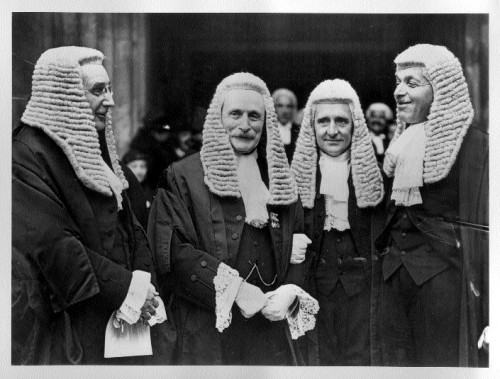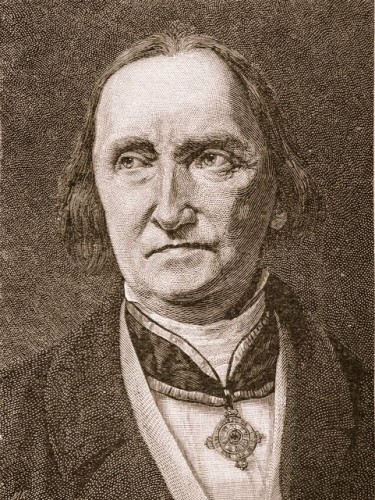
Savigny: The Volksgeist & Law
Andrew Hamilton
Ex: http://www.counter-currents.com/
Before they addressed themselves to the impractical task of changing men by changing laws, the justices might have pondered the words of Savigny, who wrote, ‘Law is no more made by lawyers than language by grammarians. Law is the natural moral product of a people . . . the persistent customs of a nation, springing organically from its past and present. Even statute law lives in the general consensus of the people.’” –Wilmot Robertson, The Dispossessed Majority (1981)
The concept of the Volksgeist, or “the spirit of the Volk,” was developed by German philosopher Johann Gottfried von Herder (1744–1803). The application of Herder’s theory to law was made by German jurist and legal historian Friedrich Karl von Savigny (1779–1861).
Herder’s Volksgeist is a manifestation of the people; it animates the nation. Every Volk is, as an empirical matter, different from every other Volk, each nationality characterized by its own unique spirit. Every people possesses its own cultural traits shaped by ancestral history and the experience of a specific physical environment, and mentally constructs its social life through language, law, literature, religion, the arts, customs, and folklore inherited from earlier generations. The Volk, in other words, is the family writ large.
Laws, too, must be adapted to the spirit of each nation, for rules applied to one nation are not valid for another. The only legitimate governments are those that develop naturally among particular nations and reflect, in their differences from other polities, the cultures of the people they govern.
Law is the unique creation of a race, a people, a Volk. Like language or values, it is the result of collective human action and reason over generations, not the result of human design. Language and law were never consciously invented at a specific moment in time. Rather, they represent slow accumulations, organic emanations of discrete peoples.
To cite but one example, European law and values and Jewish law and values are as different as night and day. In adopting torture, assassination, criminalization of free speech, thought, and association, genocide, and the abolition of formal restraints on tyranny, whites overnight lost half a millennium or more of slow, painful moral and legal progress.
Descendant of Landed Nobility
Savigny was the descendant of a distinguished Huguenot family from Lorraine, in France, which moved to Germany in 1730 to escape Catholic intolerance. The family derived its name from the Castle of Savigny in the valley of the Moselle River; its members retained their German allegiance upon the transfer of Lorraine to France.
Savigny was born in Frankfurt, the son of a Lutheran father and a Calvinist mother. Orphaned at thirteen, without parents or siblings, the boy was raised by his father’s best friend, a prominent German attorney and government official who, from the age of 15, plunged Savigny and his own son “into a terrible course [of education], comprising the science of law, natural law, international law, Roman law, and German law”—an experience Savigny’s chroniclers compare to John Stuart Mill’s über-rigorous schooling.
Graduating from the University of Marburg in 1800, Savigny took up teaching at the same institution. Among his students were the brothers Jacob and Wilhelm Grimm, the later philologists and mythologists famous for Grimm’s Fairy Tales. Savigny eventually secured a position for Jacob at the University of Berlin, and the two maintained a correspondence. Jacob Grimm dedicated his masterwork, Deutsche Grammatik, one of the most important works of German philology ever written, to Savigny.
Savigny married into the famous Brentano family. One of his wife’s nephews, pacifist economist Ludwig Brentano, won the Nobel Peace Prize in 1927. Savigny’s brother-in-law was the writer Clemens Brentano, and his sister-in-law was Bettina von Arnim, correspondent of Goethe and wife of romantic poet and novelist Achim von Arnim. Through his in-laws Savigny came into close contact with the Heidelberg group of Romantic writers. Savigny’s son, Karl Friedrich von Savigny (1814–1875), was a prominent Prussian diplomat and politician.
In 1810 Savigny became Professor of Roman Law at Prussia’s newly-formed University of Berlin at the request of Wilhelm von Humboldt. There he helped found the institution, served as its first Rector, and organized the law faculty. He also taught the Crown Prince, subsequently King Frederick William IV of Prussia.
Savigny’s highly influential legal works include The Law of Possession (Das Recht des Besitzes) (1803), History of Roman Law in the Middle Ages (Geschichte des römischen Rechts im Mittelalter), 6 vols. (1815–1831), in which he traced the history of Roman law from the breakup of the empire until the beginning of the 12th century and showed how it lived on in local customs, towns, ecclesiastical doctrines, and school teachings until its reemergence in the Renaissance, System of Modern Roman Law (System des heutigen römischen Rechts), 8 vols. (1840–1849), an uncompleted work on the contemporary Roman law of Europe, Miscellaneous Writings (Vermischte Schriften), 5 vols. (1850), and The Law of Contracts (Das Obligationenrecht), 2 vols. (1851–53).
As Jewish law professor Milton R. Konvitz noted:
His massive work on Roman law in the Middle Ages became the source of subjects for countless historical monographs. His students, and their students in turn, dominated historical and legal scholarship and teaching for several generations, and he was universally acknowledged as one of the most influential thinkers and scholars of the nineteenth century.
Civil Law and Common Law
Historically, there has been a disjunction between the civil law systems of continental Europe and the common law systems characteristic of England and the English-settled countries.
Civil law is based upon Roman law, which was first codified in the Twelve Tables in 450 B.C. Codification was completed in 535 A.D. in the Corpus Juris Civilis, the culminating work of Roman legal scholarship.
After the fall of the Western Roman Empire, Roman law persisted as part of Germanic law, the customary law of the ancient Germans (codified in the 5th–9th centuries A.D.), and canon law, the law of the Roman Catholic Church courts. It also remained the law of the Eastern Roman Empire, centered in modern-day Turkey, until its collapse in 1453.
The revival of classical studies during the Renaissance led to the resurrection of Roman law, as the Corpus Juris Civilis became the model for most of the legal systems of continental Europe.
The civil law system of the continent was thus a mixture of Roman law and local customary law. As a committee of legal historians observed in 1914:
The story of Western Continental Law is made up, in the last analysis, of two great movements, racial and intellectual. One is the Germanic migrations, planting a solid growth of Germanic custom everywhere, from Danzig to Sicily, from London to Vienna. The other is the posthumous power of Roman law, forever resisting, struggling, and coalescing with the other.
The importance of Roman law, Savigny wrote, is that “by reason of its high state of cultivation” it serves as a pattern for modern jurists. The importance of the local or customary law is that “it is directly and popularly connected with us.” Examination of the historical modifications of the two systems demonstrates how both Roman law and local law varied under the stress of actual needs and the application of legal theory.
Eventually, a single European civil code may replace existing national codes, and Savigny figures in current discussions about this. Here, for example, is Belgian law professor, former Advocate General of the European Court of Justice in Luxembourg, and general editor of a series of casebooks on the Common law of Europe Walter van Gerven writing for the European Commission:
The opposition between von Savigny and Thibaut [see below], regarded as an opposition between law, seen as a product of history, and law, seen as a product of reason, is somehow reflected in the opposition nowadays between those who believe that cultural differences between Member States and legal mentalities are such that no codification at European level is possible, at least not for the time being, and those who believe that codification has to come about without further delay. (p. 9)
To help overcome this difficulty, it has been suggested by some that Savigny’s historical school of law should be reconstituted on a pan-European level. (E.g., Reinhard Zimmerman, “Savigny’s Vermächtnis, Rechtsgeschichte, Rechtsvergleichung und die Begdindung einer Europäischen Rechtswissenschaft” ["Savigny's Legacy, Legal History, Unification of Law and Preconditions for European Legal Sciences"], Juristische Blätter [1998], 273.)
As an aside, it is instructive to briefly touch upon the Pan-European method behind this endeavor as described by van Gerven:
Work that is already underway should be continued on an even larger scale with “the aim of finding a European common core of legal principles and rules” and starting with the modest task of “mark(ing) out areas of agreement and disagreement, to construct a European legal lingua franca that has concepts large enough to embrace legal institutions which are functionally comparable, to develop a truly common law literature and the beginnings of a European law school curriculum.” (p. 29)
The author continues: “That this is not an easy matter appears from the literature on [European] Community law which now flourishes abundantly in any one Member State, but unfortunately very often in a closed national, or one language, circuit without reference to literature published in other Member States or other languages.” (p. 29n)
This shows how even the largest European institutions, with ample access to multilingual personnel, extensive translations, and continuous cross-border contacts and cooperation are still stymied by deeply entrenched intra-European cultural differences—particularly linguistic balkanization.
The situation is comparable but far worse for white racialists with their meager resources, inability to communicate in multiple languages, and lack of international contacts. Indeed, when racialists try to establish even one-off personal connections they are often hounded mercilessly by Jewish organizations, communist street thugs, pliant politicians and journalists, and police agencies determined to strangle white unity in the cradle. Victims of such actions have included Francis Parker Yockey, George Lincoln Rockwell, William Pierce, Tom and John Metzger, David Irving, and many others.
Unfortunately, any new Pan-European laws promulgated by existing elites will be deeply inimical to white racial survival and fundamental human rights.
The Origin of Germany’s Codification Controversy
There have been many modern codifications of civil law principles, the most famous and influential of which is the Code Napoléon (1804) of France, which strongly shaped the civil law systems of continental Europe and Latin America.
Louisiana is the only US civil law state, its law based upon French and Spanish codes and ultimately Roman law as opposed to English common law. Similarly, in Canada, French Quebec is the only province that operates under a dual system, with civil matters being governed by continental-style civil law and criminal matters by common law. The legal system of white South Africa was based upon Roman-Dutch civil law, and Scotland is considered a mixed law system.
In addition to the Code Napoléon, the major modern civil codes in effect when the German codification controversy flared were the Prussian Landrecht (Allgemeines Landrecht für die Preussischen Staaten, 1794) and the Austrian General Civil Code (Allgemeines bürgerliches Gesetzbuch, or ABGB, 1811). Today national civil codes are prevalent almost everywhere in continental Europe.
The primary difference between common law and civil code systems is ideological.
Common law is based upon precedent and gradual change, balancing tradition and reason.
The codes generally reflect the radical, utopian hyper-rationalism of the French Revolution. The French sought to abolish all prior law and replace it with new, all-encompassing norms in codified form. History was deemed irrelevant to the formulation, interpretation, and application of the French code; law ought to originate abstractly in the human mind (pure reason). A frequently repeated maxim of the legal radicals was, “I know nothing of the civil law; I know only the Code Napoléon.”
Theoretically the codes, complete, coherent, and clear, reduced all law to written form. Since lawmaking power was lodged solely in the legislature, judges could not look outside of the code for guidance. Their duty was to mechanically apply the law as set forth in the code.
Under the Holy Roman Empire there had been more than 300 German states. Between 1806 and 1815, the conqueror Napoleon organized them into the Confederation of the Rhine. Following his defeat, the Congress of Vienna (1814–15) created the German Confederation, consisting of 39 states, the most powerful of which were Prussia and the Austrian Empire. Each German state had its own system of laws which changed as you crossed the border, greatly hampering economic and political coordination.
In 1814, A. F. J. Thibault, professor of Roman Law at the University of Heidelberg, a former student of Immanuel Kant’s at the University of Königsberg and, like Savigny, a German of French Huguenot descent, proposed a unified German civil code on the French model to remedy the chaos of existing law. He set forth his proposals in a pamphlet, About the Necessity of a Common Civil Law for Germany (Über die Nothwendigkeit eines allgemeinen bürgerlichen Rechts für Deutschland).
Interestingly, though desirous of enacting a uniform system of laws for the German states, Thibault opposed political unification. As part of his proposed rationalistic reconstruction, he favored discarding Roman law, “the work of a nation which was very unlike us, and from the period of the lowest decline of the same.”
Opposing a French-style code for Germany, Savigny characterized the rationalistic legal mentality as one of “infinite arrogance” and “shallow philosophy.” Law, he maintained, could not be abstractly originated by a handful of individuals at a specified moment in time, but is organically created by the people of a nation as an expression of its Volksgeist. It is a grave error to try to consciously construct an ideal, all-encompassing legal code, to which everyone is compelled to submit. He believed that intellectuals lacked the ability to construct humane, workable legal systems in such a manner.
The Volksgeist and Law
Savigny set forth his views in an epochal pamphlet, Vom Beruf unserer Zeit für Gesetzgebung und Rechtswissenschaft (1814, 2nd rev. ed. 1828) (Eng. trans., Frederick Charles von Savigny, Of the Vocation of Our Age for Legislation and Jurisprudence, Abraham Hayward trans. [London: Littlewood, 1831]) and in an introductory article to the Journal of Historical Jurisprudence (Zeitschrift für geschichtliche Rechtswissenschaft), which he co-founded. From 1815 to 1850 it served as the organ of the historical school of jurisprudence.
The German Romanticism of the early 19th century had a strong influence on Savigny’s philosophy of law. As John Henry Merryman notes:
Savigny and his followers—influenced by Kant, Hegel, and German Romanticism—opposed this [codification] effort . . . Proponents of what came to be known as the “historical school,” these scholars maintained that it would be wrong for Germany to attempt to devise a [French-style] civil code . . . In their view, the law of a people was a historically determined organic product of that people’s development, an expression of the Volksgeist. Consequently, a thorough study of the existing German law and of its historical development was a necessary prelude to codification. Since the Roman civil law as interpreted by the medieval Italian scholars had been formally received in Germany some centuries before, a thorough historical study of German law had to include Roman law and old Germanic law as well as more recent elements of the contemporary German legal system. Under the influence of Savigny and the historical school, many German scholars turned their energies to the intensive study of legal history.
. . . The result would be a reconstruction of the German legal system according to its inherent principles and features.
Savigny considered law to be an emanation of a people’s spiritual and historical experience. It “is first developed by custom and popular acceptance, next by judicial decisions—everywhere, therefore, by internal silently operating powers, not by the arbitrary will of the law-giver.” The essential prerequisite was a deep and far-reaching appreciation of the genius of a particular Volk; the prescriptive content of the law must accord with the Volksgeist.
For Savigny, German law was an expression of the Volksgeist of the German people. Law is only properly understood in the light of past and present history, and reflects the inner convictions of Volk psychology and shared moral values. The Volksgeist, constantly changing and evolving as the German people changed and evolved, drove the slow evolution of law over the course of history. Savigny believed that the Volk of every land had a similar effect on each nation’s law.
Legal institutions and values, like music, art, or language, are an indigenous expression of the culture. Savigny, like Herder, thought that there was “an organic connection of law with the being and character of the people. . . . Law grows with the growth, and strengthens with the strength of the people, and finally dies away as the nation loses its nationality.”
Again like Herder, the Volksgeist is best understood through careful examination of historical data. That is why Savigny is considered a pillar of the historical school of jurisprudence. Time and again he traced the natural history of law, its organic growth as a living thing, and indicated the processes by which it adjusted to the needs of successive generations.
Although law initially manifests through custom, as social activity and rules grow more complex a specialist body of lawyers emerges. The lawyers who formulate law for an advanced culture seve as the representatives of the Volksgeist. Combining historical knowledge of law with a conceptual, systematic understanding of how rules interrelate with one another and with the whole, jurists separate what still has validity from that which is lifeless “and only belongs to history,” arriving thereby at a “living customary law.”
Thanks in large part to Savigny’s immense influence on 19th century German law and legal scholarship, Germany proved more resistant to the influence of the French Revolution than any other civil law nation in Europe. The German jurist decisively won the codification debate, and a new German Civil Code did not emerge until 1900. When it did, its historical orientation was in marked contrast to the revolutionary and rationalistic character of the Code Napoléon. As Merryman explains:
The German Civil Code of 1896 [Bürgerliches Gesetzbuch or BGB, effective 1900] is the opposite of revolutionary. It was not intended to abolish prior law and substitute a new legal system; on the contrary, the idea was to codify those principles of German law that would emerge from careful historical study of the German legal system. Instead of trying to discover true principles of law from man’s nature, as the French did . . . the Germans sought to find fundamental principles of German law by scientific study of the data of German law: the existing German legal system in historical context.
The Volksgeist Abroad
No one who has studied the works of Nobel Prize-winning Austrian economist and philosopher Friedrich Hayek will fail to notice the parallels between his thought and Herder’s and Savigny’s. In the case of Herder to cite but one example, there are precise parallels concerning the belief in the evolution, as opposed to the conscious invention or construction, of human languages. Though Hayek did not articulate a racial or ethnic basis for his evolutionary theory, he may be profitably read as if he had by anyone who recognizes that racial universalism is incorrect and unworkable.
It is not apparent that Hayek ever read Herder, but he was familiar with Savigny. (It is too little appreciated that Hayek received a doctorate in law from the University of Vienna.) Savigny’s theories of law are in accord with Hayek’s belief that social phenomena such as language, law, the family, morality, the free market, etc., objectively are (and normatively ought to be) the “results of human action but not of human design.” To attempt conscious, rationalistic constructions in such areas of life is an error characteristic of the totalitarian mind.
Hayek traced the influence of Edmund Burke upon the German historical school, and, in the reverse direction, “In the social sciences it was through Savigny’s follower Sir Henry Maine that the evolutionary approach re-entered the English tradition.”
Indeed, the common law of the United Kingdom and the English-settled white countries was itself an unconscious expression of the Volksgeist principle. The conservative tendency of the common law stood in marked contrast to the revolutionary ideology from which the continental codes emerged.
James Coolidge Carter, a distinguished New York attorney and opponent of 19th-century American codification, was a legal theorist in the Savigny-Maine mold. He succinctly summarized the common law method as follows:
It is agreed that the true rule must somehow be found [note he says found, not made]. Judge and advocates, all together, engage in the search. Cases more or less nearly approaching the one in controversy are adduced. Analogies are referred to. The customs and habits of men are appealed to. Principles already settled as fundamental are invoked and run out to their consequences; and finally a rule is deduced which is declared to be the one which the existing law requires to be applied to the case.
Another textbook example of the Volksgeist principle in action is Scandinavia, whose legal development has been described as follows:
Legal attitudes and legislative practices among the Nordic peoples have been very similar, and highly democratic, since early times. These concepts remained largely uninfluenced by Roman law, which spread over most of the Continent. Rather, ancient tribal laws evolved pragmatically and were passed down through generations by word of mouth. When these laws were codified, starting about 1100, they were found to be common regarding principles, differing only with particular local conditions. (Norman E. Holly, “Legal and Legislative Co-operation in the Scandinavian States,” American Bar Association Journal, November 1963, p. 1089.)
Conclusion
In his civil law casebook (1994), John Henry Merryman asked (but did not answer) the question: “Does a nation have only one Volksgeist or do ethnically diverse nations have a Volksgeist for each cultural group?”
In multiracial ex-white nations, the dominant Volk, the Jews, freely express their Volksgeist through Jewish and general law, but other groups are limited by the will of the rulers. This is true even of currently favored groups like Muslims, with their Sharia law.
But oppressed whites no longer have a Volksgeist. Culture distortion simultaneously destroys both the collective life of the people and its law, which is supplanted by a rigid, racist legal positivism characteristic of contemporary totalitarian regimes.
But if we eventually regain our freedom and independence, Savigny’s Volksgeist should inform our reacquisition of law. The applicability to a racialist jurisprudence of a view of law as organically evolved over time out of the consciousness or spirit of a people is obvious.
Because biological race consists of a system of nested hierarchies, law may be adapted to any appropriate level of specificity or generality circumstances call for. At present, a higher level of racial generality than was characteristic of the old European nationalisms appears most suitable to the needs of what is ultimately likely to be a greatly diminished, ingathered population.
 Victims of the most serious crimes recognized by mankind have no legal remedy to seek justice and compensation. International treaties, international law, supra-national tribunals and courts like the ICJ and the ICC are without consequence for the victims of crimes against peace, war crimes and crimes against humanity. The European Court of Human Rights can issue advisory opinions. Legal remedy for the victims is today, despite charters, treaties, statutes and courts as elusive, as it was under the tyranny of feudal regimes.
Victims of the most serious crimes recognized by mankind have no legal remedy to seek justice and compensation. International treaties, international law, supra-national tribunals and courts like the ICJ and the ICC are without consequence for the victims of crimes against peace, war crimes and crimes against humanity. The European Court of Human Rights can issue advisory opinions. Legal remedy for the victims is today, despite charters, treaties, statutes and courts as elusive, as it was under the tyranny of feudal regimes. 




 del.icio.us
del.icio.us
 Digg
Digg
 Bien entendu, aucun des médias français de grande diffusion n’a jugé utile d’en informer les Français, alors qu’ils sont si prompts, dans le sens inverse, à faire constamment état de la situation des droits de l’Homme en Chine.C’est à mon avis une raison supplémentaire pour porter attention à ce document.
Bien entendu, aucun des médias français de grande diffusion n’a jugé utile d’en informer les Français, alors qu’ils sont si prompts, dans le sens inverse, à faire constamment état de la situation des droits de l’Homme en Chine.C’est à mon avis une raison supplémentaire pour porter attention à ce document.






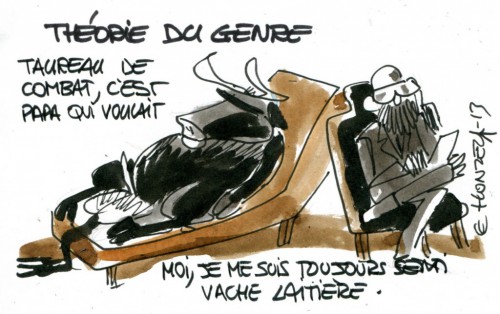

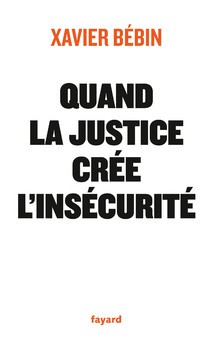 J’ai publié, voici quelques années, un livre que j’avais rédigé avec des amis juristes. J’avais décidé de l’appeler « Avancer vers l’État de droit ».
J’ai publié, voici quelques années, un livre que j’avais rédigé avec des amis juristes. J’avais décidé de l’appeler « Avancer vers l’État de droit ». Einer wollte den Führer führen. Nein: Einige wollten den Führer führen und wirkten so im Zeichen des Führers. Ob Heidegger, Rosenberg oder Spann, die Qualität ihrer Beiträge bleibt in diesem Kontext sekundär, wenn auch im Sinne der üblichen Vorwegnahme bei Spann die Betonung auf der philosophischen Stupidität liegen kann. Ihm gelang jedoch die Formierung eines Kreises, der mehr als sechzig Jahre nach seiner eigenen Entfernung von der Universität, der heutigen WU-Wien, das Gewäsch von Ganzheit wiederholt und daneben peinlich bemüht wirkt, keinen runden Geburtstag des Meisters oder seines ersten Schülers, manchmal auch des zweiten oder folgender, zu vergessen und zumeist mit einem Presseartikel, besser mit einem Jubiläumsband zu bedenken.
Einer wollte den Führer führen. Nein: Einige wollten den Führer führen und wirkten so im Zeichen des Führers. Ob Heidegger, Rosenberg oder Spann, die Qualität ihrer Beiträge bleibt in diesem Kontext sekundär, wenn auch im Sinne der üblichen Vorwegnahme bei Spann die Betonung auf der philosophischen Stupidität liegen kann. Ihm gelang jedoch die Formierung eines Kreises, der mehr als sechzig Jahre nach seiner eigenen Entfernung von der Universität, der heutigen WU-Wien, das Gewäsch von Ganzheit wiederholt und daneben peinlich bemüht wirkt, keinen runden Geburtstag des Meisters oder seines ersten Schülers, manchmal auch des zweiten oder folgender, zu vergessen und zumeist mit einem Presseartikel, besser mit einem Jubiläumsband zu bedenken.
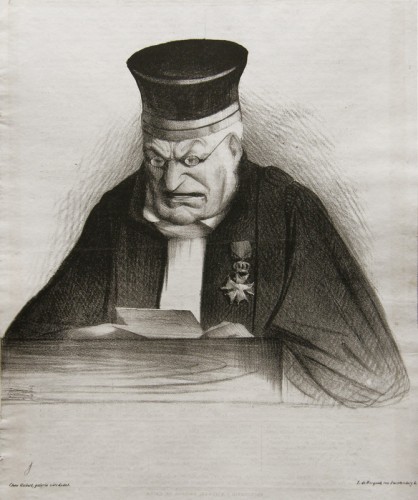
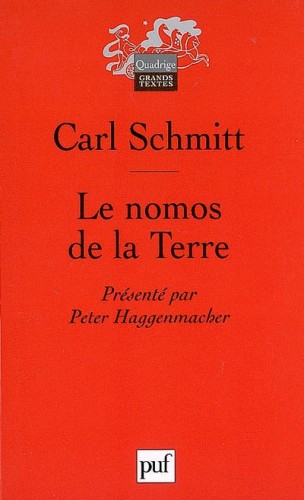 Si le nom de Carl Schmitt n’est plus tout à fait inconnu en France, où plus d’une dizaine de ses ouvrages ont déjà été traduits depuis 1972, sa personnalité reste encore très controversée. Grand théoricien du droit constitutionnel et international de l’Allemagne de l’entre deux guerres, son attitude à l’égard du nazisme lui valut d’être emprisonné plus d’une année après 1945. Refuser d’aller plus loin serait pourtant regrettable, comme ceux qui voudront bien ouvrir Le nomos de la terre s’en rendront rapidement compte. Publié en 1950 et composé dans des conditions difficiles, ce gros ouvrage offre une vue d’ensemble sur la pensée de l’auteur et passe à bon droit pour son oeuvre maîtresse.
Si le nom de Carl Schmitt n’est plus tout à fait inconnu en France, où plus d’une dizaine de ses ouvrages ont déjà été traduits depuis 1972, sa personnalité reste encore très controversée. Grand théoricien du droit constitutionnel et international de l’Allemagne de l’entre deux guerres, son attitude à l’égard du nazisme lui valut d’être emprisonné plus d’une année après 1945. Refuser d’aller plus loin serait pourtant regrettable, comme ceux qui voudront bien ouvrir Le nomos de la terre s’en rendront rapidement compte. Publié en 1950 et composé dans des conditions difficiles, ce gros ouvrage offre une vue d’ensemble sur la pensée de l’auteur et passe à bon droit pour son oeuvre maîtresse. Wem würde die geneigte Leserschaft die Beantwortung von Fragen zur Einschätzung historischer Abläufe gerne anvertrauen? Politikern? Solchen rechter Ausrichtung? Oder linker? Oder Geistlichen? Christlicher, muslimischer, jüdischer, hinduistischer oder anderer Herkunft? Oder Europäern? Oder lieber Asiaten oder Afrikanern? Deutschen oder Franzosen, Rumänen oder Portugiesen? Senegalesen oder Kongolesen, Marokkanern oder Südafrikanern? Palästinensern oder Israeli? Wahabbiten, Schiiten oder der Nato? China oder Russland? – Oder? Vielleicht doch eher der Sache und nur der Sache, also den Quellen verpflichteten Historikern, die offen sind für neue Befunde, polyperspektivisch und quellen- und ideologiekritisch vorgehen, also Interessen hinter Sachverhalten aufspüren und offenlegen – dem humanistischen und aufklärerischen Ethos verbundenen Wissenschaftern?
Wem würde die geneigte Leserschaft die Beantwortung von Fragen zur Einschätzung historischer Abläufe gerne anvertrauen? Politikern? Solchen rechter Ausrichtung? Oder linker? Oder Geistlichen? Christlicher, muslimischer, jüdischer, hinduistischer oder anderer Herkunft? Oder Europäern? Oder lieber Asiaten oder Afrikanern? Deutschen oder Franzosen, Rumänen oder Portugiesen? Senegalesen oder Kongolesen, Marokkanern oder Südafrikanern? Palästinensern oder Israeli? Wahabbiten, Schiiten oder der Nato? China oder Russland? – Oder? Vielleicht doch eher der Sache und nur der Sache, also den Quellen verpflichteten Historikern, die offen sind für neue Befunde, polyperspektivisch und quellen- und ideologiekritisch vorgehen, also Interessen hinter Sachverhalten aufspüren und offenlegen – dem humanistischen und aufklärerischen Ethos verbundenen Wissenschaftern? thk. Le 23 mars, Alfred de Zayas a été désigné, par le Conseil des droits de l’homme, comme expert indépendant auprès de l’ONU pour la promotion d’un ordre international démocratique et équitable. Il est le premier à avoir le droit d’assumer ce mandat créé en septembre 2011, pour pouvoir agir dans le domaine de la démocratisation de l’ONU et au sein des Etats nationaux unis en elle. Il est entré en fonction le 1er mai 2012. Déjà lors de la session d’automne 2012 du Conseil des droits de l’homme, Alfred de Zayas a présenté son premier rapport et a obtenu une large approbation. L’expert indépendant, qui présente une longue carrière à l’ONU, n’était pas venu tout à fait de manière inattendue à cette fonction, comme il le dit lui-même, car il s’est occupé depuis très longtemps de la question de l’organisation d’une vraie démocratie, c’est-à-dire de la démocratie directe, comme elle existe en Suisse. Avec son mandat, Alfred de Zayas souhaite s’engager pour la paix et l’égalité des peuples. «Horizons et débats» a interviewé Alfred de Zayas à l’ONU à Genève.
thk. Le 23 mars, Alfred de Zayas a été désigné, par le Conseil des droits de l’homme, comme expert indépendant auprès de l’ONU pour la promotion d’un ordre international démocratique et équitable. Il est le premier à avoir le droit d’assumer ce mandat créé en septembre 2011, pour pouvoir agir dans le domaine de la démocratisation de l’ONU et au sein des Etats nationaux unis en elle. Il est entré en fonction le 1er mai 2012. Déjà lors de la session d’automne 2012 du Conseil des droits de l’homme, Alfred de Zayas a présenté son premier rapport et a obtenu une large approbation. L’expert indépendant, qui présente une longue carrière à l’ONU, n’était pas venu tout à fait de manière inattendue à cette fonction, comme il le dit lui-même, car il s’est occupé depuis très longtemps de la question de l’organisation d’une vraie démocratie, c’est-à-dire de la démocratie directe, comme elle existe en Suisse. Avec son mandat, Alfred de Zayas souhaite s’engager pour la paix et l’égalité des peuples. «Horizons et débats» a interviewé Alfred de Zayas à l’ONU à Genève. 




.jpg)
